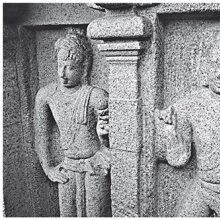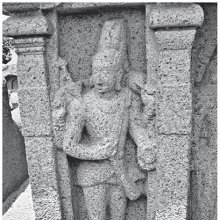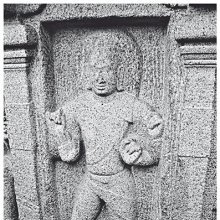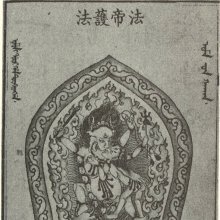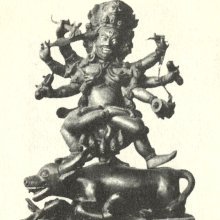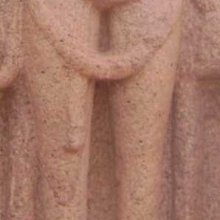Dharmaraja, Dharmarāja, Dharma-raja: 19 definitions
Introduction:
Dharmaraja means something in Buddhism, Pali, Hinduism, Sanskrit, the history of ancient India, Marathi. If you want to know the exact meaning, history, etymology or English translation of this term then check out the descriptions on this page. Add your comment or reference to a book if you want to contribute to this summary article.
Images (photo gallery)
(+12 more images available)
In Hinduism
Natyashastra (theatrics and dramaturgy)
Source: archive.org: The mirror of gesture (abhinaya-darpana)One of the Hands of Famous Emperors.—Dharmarāja: hands waved near the arms.

Natyashastra (नाट्यशास्त्र, nāṭyaśāstra) refers to both the ancient Indian tradition (shastra) of performing arts, (natya—theatrics, drama, dance, music), as well as the name of a Sanskrit work dealing with these subjects. It also teaches the rules for composing Dramatic plays (nataka), construction and performance of Theater, and Poetic works (kavya).
Purana and Itihasa (epic history)
Source: archive.org: Puranic EncyclopediaDharmarāja (धर्मराज).—A king of Gauḍadeśa. He became King at a time when Jainism was getting more and more hold on the people and the Hindu Vedic rites were getting less and less popular among the people. The King thought it was his duty to revive the interest in the Vedic rites and so became a priest himself and did much propaganda on the superiority of the same, writing several books on the subject for the benefit of the people. (Bhaviṣyapurāṇa, Pratisarga Parva).
Source: archive.org: Shiva Purana - English TranslationDharmarāja (धर्मराज) refers to the “god of death”, according to the Śivapurāṇa 2.5.18 (“The conversation between Nārada and Jalandhara”).—Accordingly, as the Gods said to Nārada: “O excellent sage, listen to our misery. O merciful one, after listening to it, destroy it quickly. You are powerful and the favourite of Śiva. [...] The hot-rayed sun and the moon have been ousted from their positions. The fire-god and the god of death (dharmarāja) and guardians of the quarters have been expelled. The gods have been harassed by that powerful Asura. We who have been subjected to great grief now seek refuge in you. [...]”.
Source: Cologne Digital Sanskrit Dictionaries: The Purana Index1a) Dharmarāja (धर्मराज).—A name of Yudhiṣṭhira.*
- * Bhāgavata-purāṇa I. 12. 4 ff; Viṣṇu-purāṇa V. 38. 90.
1b) Yama with residence in Kurukṣetra;1 son of Sūrya.2
- 1) Brahmāṇḍa-purāṇa II. 29. 65; III. 13. 67; 59. 79; Vāyu-purāṇa 108. 5, 106. 44; 111. 38.
- 2) Vāyu-purāṇa 84. 80; Viṣṇu-purāṇa III. 7. 19 and 35.

The Purana (पुराण, purāṇas) refers to Sanskrit literature preserving ancient India’s vast cultural history, including historical legends, religious ceremonies, various arts and sciences. The eighteen mahapuranas total over 400,000 shlokas (metrical couplets) and date to at least several centuries BCE.
In Buddhism
Mahayana (major branch of Buddhism)
Source: Wisdom Library: LokottaravādaDharmarāja (धर्मराज) is the name of a Buddha under whom Śākyamuni (or Gautama, ‘the historical Buddha’) acquired merit along the first through nine bhūmis, according to the Mahāvastu. There are in total ten bhūmis representing the ten stages of the Bodhisattva’s path towards enlightenment.
Dharmarāja is but one among the 500 Buddhas enumerated in the Mahāvastu during a conversation between Mahākātyāyana and Mahākāśyapa, both principle disciples of Gautama Buddha. The Mahāvastu is an important text of the Lokottaravāda school of buddhism, dating from the 2nd century BCE.
Source: academia.edu: A Study and Translation of the GaganagañjaparipṛcchāDharmarāja (धर्मराज) is the name of a Bodhisattva, according to the Gaganagañjaparipṛcchā: the eighth chapter of the Mahāsaṃnipāta (a collection of Mahāyāna Buddhist Sūtras).—Accordingly: “Then, the Bodhisattva, Dharmarāja by name, addressed himself to the Bodhisattva Gaganagañja: ‘Son of good family, let me listen to the treasury of hearing the dharma from open space’. Gaganagañja said: ‘If you conceive the concept of this open space as your teacher, with respect and reverence, son of good family, then you will listen to the treasury of hearing the dharma’. [...]”.

Mahayana (महायान, mahāyāna) is a major branch of Buddhism focusing on the path of a Bodhisattva (spiritual aspirants/ enlightened beings). Extant literature is vast and primarely composed in the Sanskrit language. There are many sūtras of which some of the earliest are the various Prajñāpāramitā sūtras.
India history and geography
Source: Cologne Digital Sanskrit Dictionaries: Indian Epigraphical GlossaryDharmarāja.—(EI 28), royal title; title of a pious king; cf. Dharma-mahārāja, etc.; also dharmarājikā. Note: dharmarāja is defined in the “Indian epigraphical glossary” as it can be found on ancient inscriptions commonly written in Sanskrit, Prakrit or Dravidian languages.

The history of India traces the identification of countries, villages, towns and other regions of India, as well as mythology, zoology, royal dynasties, rulers, tribes, local festivities and traditions and regional languages. Ancient India enjoyed religious freedom and encourages the path of Dharma, a concept common to Buddhism, Hinduism, and Jainism.
Languages of India and abroad
Marathi-English dictionary
Source: DDSA: The Molesworth Marathi and English Dictionarydharmarāja (धर्मराज).—m (S) The name of the eldest of the five pāṇḍava princes. Hence applied to an upright or virtuous person gen. 2 A name of Yama, Regent of the dead.
Source: DDSA: The Aryabhusan school dictionary, Marathi-Englishdharmarāja (धर्मराज).—m The name of the eldest of the five pāṇḍava princes. Hence applied to an upright or virtuous person.
Marathi is an Indo-European language having over 70 million native speakers people in (predominantly) Maharashtra India. Marathi, like many other Indo-Aryan languages, evolved from early forms of Prakrit, which itself is a subset of Sanskrit, one of the most ancient languages of the world.
Sanskrit dictionary
Source: DDSA: The practical Sanskrit-English dictionaryDharmarāja (धर्मराज).—a. धर्मशील (dharmaśīla) q. v.; धर्मराजेन जनकेन महात्मना (dharmarājena janakena mahātmanā) (videhān rakṣitān) Mahābhārata (Bombay) 12.325 19.
Dharmarāja is a Sanskrit compound consisting of the terms dharma and rāja (राज).
--- OR ---
Dharmarāja (धर्मराज).—an epithet of
1) Yama.
2) Jina.
3) युधिष्ठिर (yudhiṣṭhira).
4) a king.
Derivable forms: dharmarājaḥ (धर्मराजः).
Dharmarāja is a Sanskrit compound consisting of the terms dharma and rāja (राज).
Source: Cologne Digital Sanskrit Dictionaries: Edgerton Buddhist Hybrid Sanskrit DictionaryDharmarāja (धर्मराज).—(n) , (mgs. 1 and 2 = Pali dhammarāja), (1) king of the doctrine or religious, righteous king, epithet of Buddha: Lalitavistara 214.13; 395.9; 426.19; 437.18; °ja-putra (= jina-putra etc., of disciples or Bodhisattvas) Mahāvyutpatti 1090; (2) lawful (or righteous) king, as standing epithet of a cakravartin (compare Pali Dīghanikāya (Pali) commentary i.249.29, glossed dham- mena rajjaṃ labhitvā rājā jāto ti): Mahāvyutpatti 3618; Lalitavistara 14.3; 101.13; (3) name of a former Buddha: Mahāvastu i.138.2 (°jaḥ).
Source: Cologne Digital Sanskrit Dictionaries: Shabda-Sagara Sanskrit-English DictionaryDharmarāja (धर्मराज).—m.
(-jaḥ) 1. A Jain or deified saint, according to the Jaina sect. 2. A name of Yama, regent of the dead. 3. A name of Yud'Hish- Thira. 4. Also of Arjuna. 5. A king in general. E. dharma virtue, Justice, and rāja who shines, affix ac; or rāja from rājan a king; lord of justice or dharmeṇa rājate . rāja-kvip .
Source: Cologne Digital Sanskrit Dictionaries: Benfey Sanskrit-English DictionaryDharmarāja (धर्मराज).—m. epithet of Yama and Yudhiṣṭhira, Mahābhārata 13, 3471; [Harivaṃśa, (ed. Calc.)] 842.
Dharmarāja is a Sanskrit compound consisting of the terms dharma and rāja (राज).
Source: Cologne Digital Sanskrit Dictionaries: Cappeller Sanskrit-English DictionaryDharmarāja (धर्मराज).—[masculine] king of justice, [Epithet] of Yama & Yudhiṣṭhira.
Source: Cologne Digital Sanskrit Dictionaries: Aufrecht Catalogus Catalogorum1) Dharmarāja (धर्मराज) as mentioned in Aufrecht’s Catalogus Catalogorum:—Kavijīvana lex. Burnell. 52^a.
2) Dharmarāja (धर्मराज):—Ṣaṭpraśnopaniṣaṭṭīkā. Oppert. Ii, 131.
3) Dharmarāja (धर्मराज):—Sabhāpativilāsa nāṭaka. Burnell. 174^a.
4) Dharmarāja (धर्मराज):—Hariharastotra. Burnell. 203^a.
5) Dharmarāja (धर्मराज):—son of Trivedin Nārāyaṇa Yajvan, of the Kauṇḍinya family, inhabitant of Kaṇḍaramāṇikyagrāma. Acording to Burnell., identical with the author of the Vedāntaparibhāṣā. Tattvacintāmaṇiprakāśadīpti. Oppert. 1956. Tarkacūḍāmaṇi, a
—[commentary] on the Tattvacintāmaṇisāra of Gopīnātha. Tarkacūḍāmaṇi Nyāyaśikhāmaṇiṭīkā. Dharmarājadīkṣitīya [nyāya] Oppert. 3415. Ii, 4306. 5949. 9594.
—[commentary] Ii, 9595.
1) Dharmarāja (धर्मराज):—[=dharma-rāja] [from dharma > dhara] m. ‘id.’ a just or righteous king, [Harivaṃśa]
2) [v.s. ...] any king or prince, [cf. Lexicographers, esp. such as amarasiṃha, halāyudha, hemacandra, etc.]
3) [v.s. ...] a Buddha, [cf. Lexicographers, esp. such as amarasiṃha, halāyudha, hemacandra, etc.]
4) [v.s. ...] Name of Yama, [Mahābhārata; Harivaṃśa; Daśakumāra-carita] etc. (-tā f., [Mahābhārata])
5) [v.s. ...] of Yudhiṣṭhira, [Mahābhārata; Harivaṃśa] (-purogama mfn. headed by Y°, [Monier-Williams’ Sanskrit-English Dictionary])
6) [v.s. ...] Law conceived as a king, [Kāraṇḍa-vyūha]
7) [v.s. ...] Name of sub voce authors (also -dīkṣita m. [-dīkṣitīya n. his [work]], -putra m., -bhaṭṭa m., jādhvari-vara m. and jādhvarindra m.)
Source: Cologne Digital Sanskrit Dictionaries: Yates Sanskrit-English DictionaryDharmarāja (धर्मराज):—[dharma-rāja] (jaḥ) 1. m. A Jaina sage: any king; Yama; Yudhishthira; Arjuna.
[Sanskrit to German]
Sanskrit, also spelled संस्कृतम् (saṃskṛtam), is an ancient language of India commonly seen as the grandmother of the Indo-European language family (even English!). Closely allied with Prakrit and Pali, Sanskrit is more exhaustive in both grammar and terms and has the most extensive collection of literature in the world, greatly surpassing its sister-languages Greek and Latin.
See also (Relevant definitions)
Partial matches: Dharma, Raja, Tarma.
Starts with: Dharmaraja Adhvarindra, Dharmaraja adhvarivara, Dharmaraja bhatta, Dharmarajabhatta, Dharmarajaci Bija, Dharmarajadhvarindra, Dharmarajadhvarivara, Dharmarajadikshita, Dharmarajadikshitiya, Dharmarajan, Dharmarajaniveshana, Dharmarajapurogama, Dharmarajaputra, Dharmarajata, Dharmarajatirtha.
Full-text (+69): Yudhishthira, Yama, Dharmarajata, Dharmarajadikshita, Dharmarajaputra, Dharmarajabhatta, Dharmarajadikshitiya, Dharmarajapurogama, Dharmarajadhvarivara, Taruma-racakal, Dattaratnakara, Caritarthay, Sabhapativilasa, Dharmaraja bhatta, Advaitaparibhasha, Dharmaraja adhvarivara, Kavijivana, Nrisimha yatindra, Amitadhvaja, Mati.
Relevant text
Search found 71 books and stories containing Dharmaraja, Dharmarāja, Dharma-raja, Dharma-rāja; (plurals include: Dharmarajas, Dharmarājas, rajas, rājas). You can also click to the full overview containing English textual excerpts. Below are direct links for the most relevant articles:
Puranic encyclopaedia (by Vettam Mani)
Brihad Bhagavatamrita (commentary) (by Śrī Śrīmad Bhaktivedānta Nārāyana Gosvāmī Mahārāja)
Verse 1.1.6 < [Chapter 1 - Bhauma (the earthly plane)]
Verse 1.5.4-5 < [Chapter 5 - Priya (the beloved devotees)]
Verse 1.5.2-3 < [Chapter 5 - Priya (the beloved devotees)]
Kathasaritsagara (the Ocean of Story) (by Somadeva)
Chapter LXXXVII < [Book XII - Śaśāṅkavatī]
On the glories of Gayā (Gayāmāhātmya) < [Notes]
Garga Samhita (English) (by Danavir Goswami)
Verses 6.15.43-44 < [Chapter 15 - The Glories of Nṛga-kūpa and Gopī-bhūmi]
The Matsya Purana (critical study) (by Kushal Kalita)
Part 1g - The Legend of Sāvitrī-Satyavāna < [Chapter 3 - Historical aspects in the Matsyapurāṇa]
Part 1.2 - Viṣṇu as the Supreme reality < [Chapter 4 - Religious aspects of the Matsyapurāṇa]
Part 3 - Art in the Matsyapurāṇa < [Chapter 7 - Art and Architecture in the Matsyapurāṇa]
The Skanda Purana (by G. V. Tagare)
Chapter 138 - Origin of Dharmarājeśvara < [Section 1 - Tīrtha-māhātmya]
Chapter 136 - Origin of Dīrghikā < [Section 1 - Tīrtha-māhātmya]
Chapter 139 - Greatness of Dharmarājeśvara (Dharmarāja-īśvara) < [Section 1 - Tīrtha-māhātmya]
Related products
